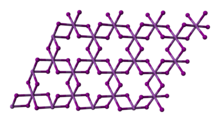Scandium chloride
 Crystals of scandium(III) chloride hexahydrate
| |
 | |
| Names | |
|---|---|
| IUPAC name
Scandium(III) chloride
| |
| Other names
scandium chloride
scandium trichloride | |
| Identifiers | |
3D model (JSmol)
|
|
| ChemSpider | |
| ECHA InfoCard | 100.030.714 |
PubChem CID
|
|
| RTECS number |
|
| UNII | |
CompTox Dashboard (EPA)
|
|
| |
| |
| Properties | |
| ScCl3 | |
| Molar mass | 151.31 g/mol |
| Appearance | grayish-white crystals |
| Density | 2.39 g/mL, solid |
| Melting point | 960 °C (1,760 °F; 1,230 K)[1] 63 °C (hexahydrate) |
| 70.2 g/100 mL | |
| Solubility in other solvents | soluble in alcohol, acetone, glycerin insoluble in EtOH[citation needed] |
| Hazards | |
| Occupational safety and health (OHS/OSH): | |
Main hazards
|
irritant |
| NFPA 704 (fire diamond) | |
| Lethal dose or concentration (LD, LC): | |
LD50 (median dose)
|
3980 mg/kg (mouse, oral) |
| Safety data sheet (SDS) | External MSDS |
| Related compounds | |
Other anions
|
Scandium(III) fluoride Scandium bromide Scandium triiodide |
Other cations
|
Yttrium(III) chloride Lutetium(III) chloride |
Related compounds
|
Scandium(III) nitrate |
Except where otherwise noted, data are given for materials in their standard state (at 25 °C [77 °F], 100 kPa).
| |
Scandium(III) chloride is the inorganic compound with the formula ScCl3. It is a white, high-melting ionic compound, which is deliquescent and highly water-soluble.[2] This salt is mainly of interest in the research laboratory. Both the anhydrous form and hexahydrate (ScCl3•6H2O) are commercially available.
Structure
[edit]ScCl3 crystallises in the layered BiI3 motif, which features octahedral scandium centres.[3] Monomeric ScCl3 is the predominant species in the vapour phase at 900 K, the dimer Sc2Cl6 accounts for approximately 8%.[4] The electron diffraction spectrum indicates that the monomer is planar and the dimer has two bridging Cl atoms each Sc being 4 coordinate.[4]
Reactions
[edit]
ScCl3 is a Lewis acid that absorbs water to give aquo complexes. According to X-ray crystallogrphy, one such hydrate is the salt trans-[ScCl2(H2O)4]Cl·2H2O.[5] With the less basic ligand tetrahydrofuran, ScCl3 yields the adduct ScCl3(THF)3 as white crystals. This THF-soluble complex is used in the synthesis of organoscandium compounds.[6] ScCl3 has been converted to its dodecyl sulfate salt, which has been investigated as a "Lewis acid-surfactant combined catalyst" (LASC) in aldol-like reactions.[7]
Reduction
[edit]Scandium(III) chloride was used by Fischer et al. who first prepared metallic scandium by electrolysis of a eutectic melt of scandium(III) chloride and other salts at 700-800 °C.[8]
ScCl3 reacts with scandium metal to give a number of chlorides where scandium has an oxidation state <+3, ScCl, Sc7Cl10, Sc2Cl3, Sc5Cl8 and Sc7Cl12.[2][9] For example, reduction of ScCl3 with scandium metal in the presence of caesium chloride gives the compound CsScCl3 which contain linear chains of composition ScIICl3−, containing ScIICl6 octahedra sharing faces.[10]
Uses
[edit]Scandium(III) chloride is found in some halide lamps, optical fibers, electronic ceramics, and lasers.[11]
References
[edit]- ^ Frederikse, H.P.R.; Lide, David R. (1998). CRC Handbook of Chemistry and Physics (78th Edition)
- ^ a b Greenwood, Norman N.; Earnshaw, Alan (1997). Chemistry of the Elements (2nd ed.). Butterworth-Heinemann. ISBN 978-0-08-037941-8.
- ^ Crystal Structure of ScCl3 Refined from Powder Neutron Diffraction Data, Fjellvåg, H., Karen, P., Acta Chemica Scandinavica, 48, 294-297, doi:10.3891/acta.chem.scand.48-0294
- ^ a b Haaland A., Martinsen K-G, Shorokhov D.J, Girichev G.V., Sokolov V.I, J. Chem. Soc., Dalton Trans., 1998, 2787 - 2792, doi:10.1039/a803339k
- ^ The Rare Earth Elements, Fundamentals and Applications David A. Atwood, 2012, John Wiley & Sons Inc, ISBN 9781119950974
- ^ Manzer, L. E., "Tetrahydrofuran Complexes of Selected Early Transition Metals", Inorganic Syntheses, 1982, volume 21, page 135-40.doi:10.1002/9780470132524.ch31
- ^ Manabe, Kei; Mori, Yuichiro; Kobayashi, Shū (1999). "Effects of Lewis acid-surfactant-combined catalysts on aldol and Diels-Alder reactions in water". Tetrahedron. 55 (37): 11203–11208. doi:10.1016/S0040-4020(99)00642-0.
- ^ Fischer, Werner; Brünger, Karl; Grieneisen, Hans (1937). "Über das metallische Scandium". Zeitschrift für anorganische und allgemeine Chemie. 231 (1–2): 54–62. doi:10.1002/zaac.19372310107.
- ^ Corbett, J.D. (1981). "Extended metal-metal bonding in halides of the early transition metals". Acc. Chem. Res. 14 (8): 239–246. doi:10.1021/ar00068a003.
- ^ Meyer, Gerd.; Corbett, John D. (1981). "Reduced ternary halides of scandium: RbScX3 (X = chlorine, bromine) and CsScX3 (X = chlorine, bromine, iodine)". Inorganic Chemistry. 20 (8): 2627–2631. doi:10.1021/ic50222a047. ISSN 0020-1669.
- ^ Metal Suppliers Online. (2000). Scandium Chloride

